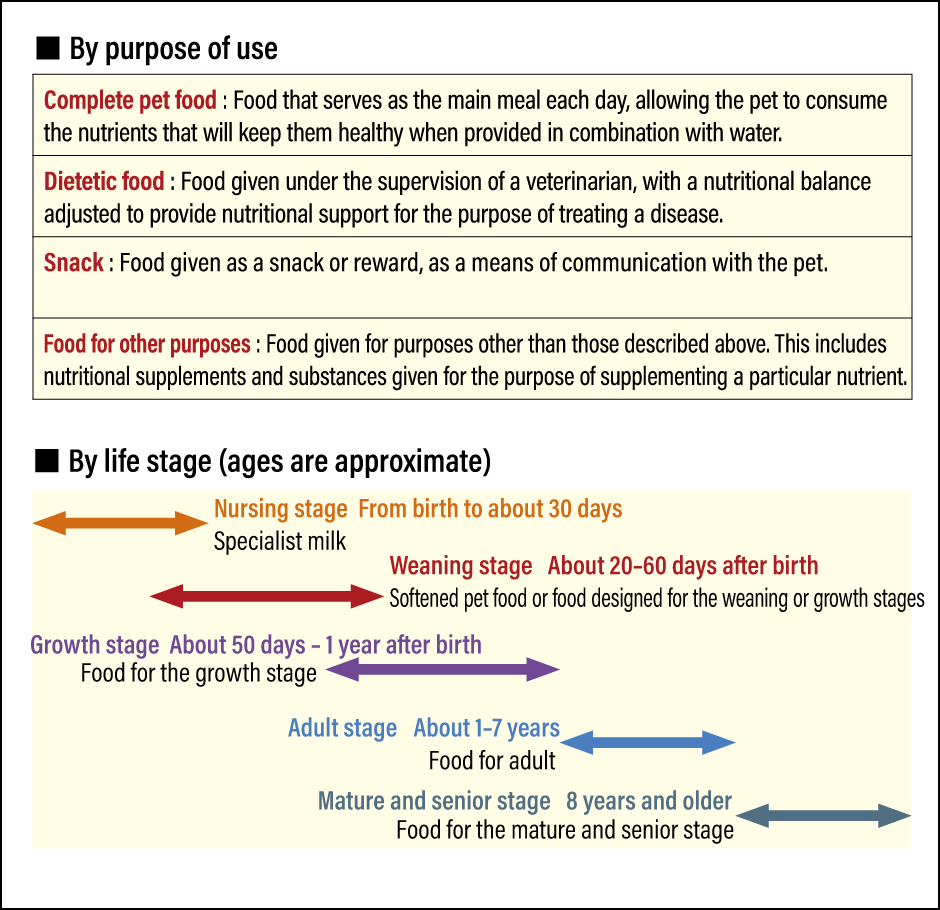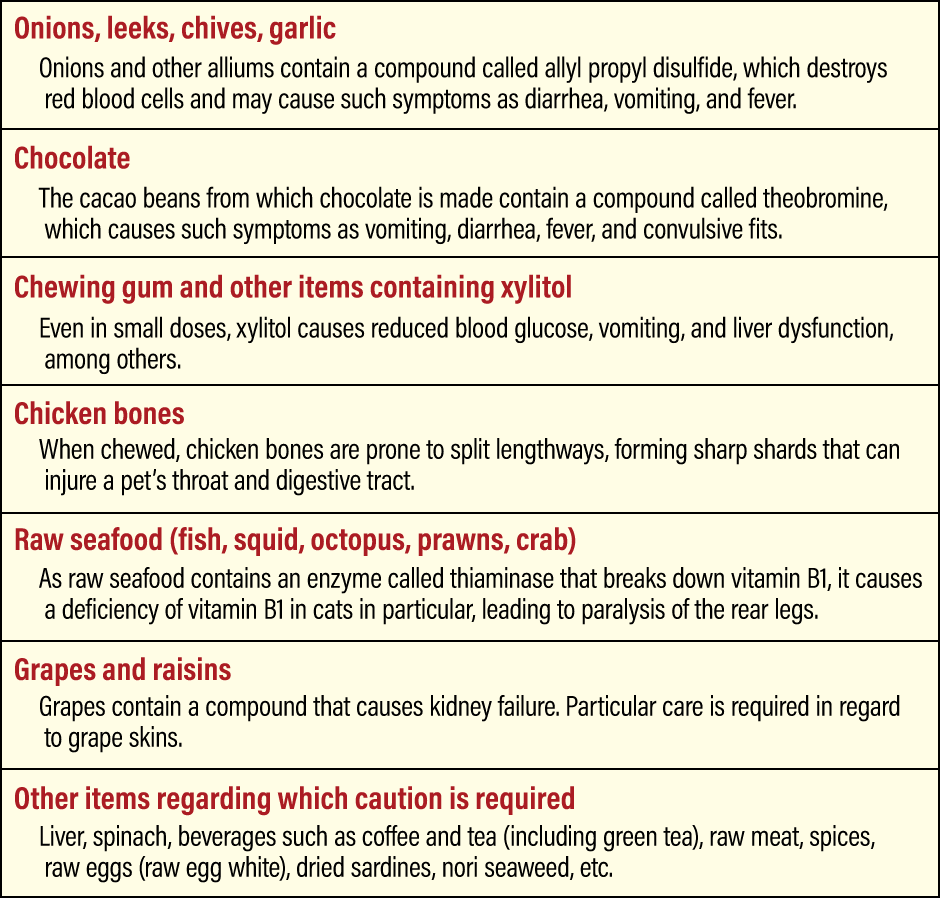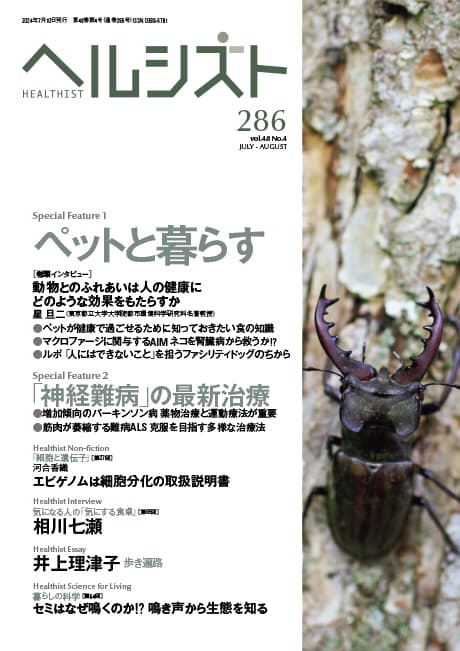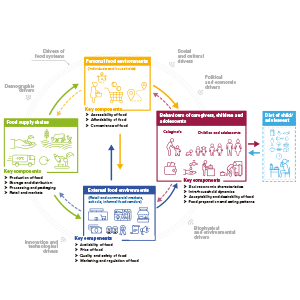Food is a very important part of ensuring that pets lead healthy lives. However, their feeding behaviors vary, with dogs being omnivores or carnivorous omnivores, whereas cats are obligate carnivores, so meticulous attention must be paid to what they are fed. Today, one can get by without worrying about it too much, because optimized pet foods are readily available at supermarkets and convenience stores. However, fresh concerns have surfaced, as cases of metabolic syndrome are even being seen among cats and dogs. Just as with humans, we need the correct dietary knowledge to ensure that our precious pets can live long, healthy lives.
Special Feature 1 – Living with Pets The dietary knowledge you need to keep your pet healthy
composition by Toshiko Mogi
We humans ingest nutrients by eating various foods, which keeps us alive and enables us to carry out physical activity. Cats and dogs are no different from humans in this regard. However, cats and dogs do differ slightly from humans in terms of such matters as their feeding behaviors and the nutrients they require.
First of all, let us touch upon the ways in which cats and dogs differ from humans.
Dogs are omnivores, while cats are obligate carnivores
The first area in which cats and dogs differ from humans is in their feeding behaviors. The term “feeding behaviors” here refers to the attributes of both the behavior when consuming food and the things that are eaten.
Feeding behaviors are divided into such categories as omnivorous, herbivorous, and carnivorous. Humans are omnivores, eating meat, fish, and vegetables alike, while dogs are omnivores or carnivorous omnivores, and cats are obligate carnivores.
We know from genetic information that dogs are descended from wolves. Accordingly, one might imagine that dogs are carnivorous. While wolves prey on herbivorous animals, the internal organs of their prey contain plant residues, which wolves are thought to consume with the rest of the animal. In fact, wolves are actually not very good hunters and are said to stave off starvation by eating plants when they cannot capture prey. Dogs’ feeding behavior as omnivores or carnivorous omnivores is attributed to the fact that they are descended from wolves, which eat both meat and plants, and have long lived with humans, who eat anything.
The next major difference is the way in which they eat. We humans masticate, chewing food in our mouth, then mixing it with saliva before swallowing. However, cats and dogs do not masticate. Once they have used their teeth to tear food into shreds small enough to pass through their gullet, they swallow it as it is. It is then digested and absorbed as it passes from the esophagus to the stomach, small intestine, and large intestine.
While the digestion and absorption pathways are the same, herbivorous and carnivorous animals differ in the length of their intestinal tract. Carnivores have a short intestinal tract because their food takes a short time to be digested, whereas herbivores have a long intestinal tract because it takes longer to digest their food. For example, a cat’s intestines are said to be four times the length of its body, whereas a dog’s is five or six times, as is a human’s.
Maintaining a healthy gut is also recommended for canine and feline health
Cats and dogs can live healthy lives as long as they have safe, well-balanced food suitable for their species. However, no matter how good their food is from a nutritional standpoint, it will be difficult for them to stay healthy if the gut that absorbs those nutrients is not healthy, as they will be unable to absorb the nutrients they need. Accordingly, in recent years, experts have begun to recommend efforts to maintain a healthy intestinal environment for the sake of canine and feline health.
The nutrients required by cats and dogs are exactly the same as those needed by humans: the three major nutrients —— namely, protein, fat, and carbohydrates —— to which vitamins and minerals should be added to make up the five major nutrients. However, the proportions of each that should be consumed differ from the amounts recommended for humans, with cats and dogs requiring more protein (Figure 1). This is closely related to the feeding behaviors described above: cats and dogs require a larger amount of protein than humans and, as obligate carnivores, cats require even more protein than dogs. Protein is the material from which bodies are built; in the case of cats and dogs, a lack of protein causes a decline in body weight and reduced fur growth, and can also lead to growth retardation if insufficient protein is consumed during the growth period.
 Compiled on the basis of Ministry of the Environment, Learn and Understand! Pet Food Labels: Understand How to Read Labels Properly to Keep Your Pet Safe and Healthy
Compiled on the basis of Ministry of the Environment, Learn and Understand! Pet Food Labels: Understand How to Read Labels Properly to Keep Your Pet Safe and Healthy
Figure 1. Differences in the nutritional balance required by petsHumans, cats, and dogs require different proportions of the three major nutrients. Cats and dogs are covered in fur, the building blocks for which are provided by protein.
Protein is composed of amino acids; the amino acids that cannot be produced in the body and therefore have to be consumed from food are called essential amino acids. Whereas humans have nine essential amino acids, cats and dogs have ten, with arginine the extra one. In cats in particular, a lack of arginine causes hyperammonemia —— excessive ammonia in the blood —— which can be fatal. Formerly classified as an amino acid, taurine is an essential nutrient for cats that, when lacking, can cause liver dysfunction, dilated cardiomyopathy, and retinal atrophy.
While pets are members of the family that live with us, animals of different species have different nutritional requirements that are crucial to staying healthy. These days, pet food is sold in supermarkets and convenience stores, so even people with no experience of pet ownership likely understand that animals need to be given animal food.
In fact, the human diet is too high in fat, which cats and dogs cannot digest appropriately. This can cause vomiting and diarrhea, and in some cases may lead to more serious conditions, such as pancreatitis. In addition, the sodium (salt) levels of most human food are so high as to cause health problems in cats and dogs. This is why cats and dogs require pet food designed to support their respective health and survival needs.
Pet foods are classified into categories according to purpose of use: complete pet food, dietetic food, snack, and food for other purposes (Figure 2). All four types are also classified by moisture content: dry products, intermediate moisture products (semi-moist food or soft dry food), and wet products.
 Compiled on the basis of Ministry of the Environment, Pet Food Guidelines for Owners: Keeping Your Cat and Dog Healthy
Compiled on the basis of Ministry of the Environment, Pet Food Guidelines for Owners: Keeping Your Cat and Dog Healthy
Figure 2. How to choose pet foodThe nutritional balance and calories required by pets differs according to their life stage. When choosing pet food, be sure to check its nutritional composition and the recommended daily serving.
Complete pet foods are foods that have been produced to be a pet’s staple food in addition to water, with a nutritional balance designed to keep a cat or dog healthy.
A pet’s staple food needs to be altered according to their life stage, namely the breeding stage (pregnancy and lactation stage), nursing stage, weaning stage, growth stage, adult maintenance stage, and senior stage. Revising the nutritional balance and calories provided according to your pet’s life stage to ensure appropriate weight management is fundamental to keeping your pet healthy.
The only pet foods that can be labeled as complete pet foods are those that meet the nutritional standards prescribed by the Pet Food Fair Trade Association in compliance with the standards of the Association of American Feed Control Officials (AAFCO), which serve as guidelines for pet food nutritional standards worldwide. In order to be permitted to label a food as a complete pet food, the manufacturer must also carry out analytical tests and feeding tests, on their own responsibility.
Dietetic food is pet food provided for the purpose of supporting treatment, in which the quantities and proportions of the nutritional components have been adjusted according to the nature of the treatment being administered to a cat or dog with a disease. Cats and dogs for whom dietary management is essential in order to treat a disease such as diabetes or kidney disease are given dietetic food under the supervision of a veterinarian.
Dietetic food can readily be purchased at a pet supplies shop. Nevertheless, pet owners must not purchase such food based on their own judgment; for example, they must not buy a dietetic food designed to support the gastrointestinal system just because their pet seems to be having minor tummy troubles, or one designed for managing weight/obesity just because their pet has put on a little weight.
Dietetic food should be used under the supervision and guidance of a veterinarian, with the pet undergoing regular check-ups; this is in the pet’s best interest. This is because some dietetic food has a nutritional balance that has been adjusted in an extreme way, as it is designed for short-term treatment. In addition, a cat or dog’s condition may change, depending on the treatment and dietetic food they receive. There are cases in which it is necessary to change to a different dietetic food or switch to a complete pet food, according to the condition of the pet.
In recent years, functional pet foods have also become commercially available; these are foods in which the nutrients have been considered according to their purpose, in order to maintain and improve canine or feline health. These are the same as food with function claims for humans (foods that, on the manufacturer’s responsibility, bear a label stating that they can be expected to serve a specific health maintenance purpose, based on scientific evidence), and are fundamentally different from dietetic food.
Foods that cats and dogs enjoy
There are foods that cats and dogs enjoy, just like humans enjoy sweets or alcohol. These are pet snacks, which are given as snacks between meals or as a reward. They are available in a wide range of types, with different ingredients, flavors, textures, and shapes. However, if you give your cat or dog a snack every time it wants one, their nutritional balance will be impaired, with a risk of causing obesity. On a calorie basis, snacks should make up no more than 10–20% of a pet’s daily food intake. Ensure that you reduce your pet’s staple food intake by the amount of calories it has consumed as snacks. Do also make sure that you refer to the product package as well, as it will have information about the recommended daily intake and number of times per day the snacks may be given.
Quite a few pet owners want to give their pets homemade food, rather than commercially available pet food. However, it is likely to be difficult to manage the pet’s nutritional needs if you rely entirely on homemade food. I believe that a practical approach to nutrition management is to aim for about 10% of the pet’s meal on a calorie basis to be a homemade topping, with the remaining 90% consisting of pet food.
There are substances in some foods that must not be fed to cats or dogs. Some of the foods that we humans eat and enjoy can even threaten the life of a cat or dog.
Many such forbidden foods are dangerous to cats and dogs alike. Moreover, where the cat or dog is small in size, adverse effects are more likely to occur even when small amounts of these foods are consumed, whereas in larger dogs, even lesser amounts of poisonous food per kilogram of body weight leads to the same negative outcome. Particular caution is therefore required. Let us now look at the main examples of common foods in everyday life that are dangerous if eaten by cats or dogs, and the symptoms that they cause (Table).
 Compiled on the basis of Ministry of the Environment, Pet Food Guidelines for Owners: Keeping Your Cat and Dog Healthy
Compiled on the basis of Ministry of the Environment, Pet Food Guidelines for Owners: Keeping Your Cat and Dog Healthy
Table. Foods that must not be given to petsIf your cat or dog has accidentally consumed any of the food or drink listed in the table above, take your pet to a veterinary hospital without delay.
Alliums such as onions, leeks, chives, and garlic, with similar scents and flavors contain substances like allyl propyl disulfide, an organic thiosulfate compound. Reportedly, one effect of such compounds is to oxidize the hemoglobin in canine and feline red blood cells. Accordingly, if a pet eats a large quantity of a food containing these compounds, it can suffer damage to the lipid membrane of its red blood cells, which can cause conditions such as hemolytic anemia and hemoglobinuria, and also risks causing anemia and diarrhea, among others.
Even when such foods are heated or boiled down to a mush, the substances that cause health problems are not broken down and remain in the broth. In particular, onions are not only used in a wide range of dishes, from Japanese to Western cuisine, but are also used in various condiments, including ketchup and other sauces, and onion powder. Caution is required to ensure cats and dogs do not accidentally eat these.
It is safer to avoid feeding raw meat or fish to pets, as there is a possibility that bacterial contamination could cause food poisoning. Seafood in particular needs to be heated up. This is because seafood such as raw squid and prawns contain high levels of an enzyme called thiaminase. This enzyme breaks down vitamin B1, whose role in the body is to turn carbohydrates into energy. Accordingly, if pets are given too much raw seafood and become deficient in vitamin B1, they will become unable to produce energy properly, which will even affect brain function and may cause motor function disorders, such as becoming unable to walk properly. Cats in particular require a large amount of vitamin B1 and are therefore more prone to symptoms than dogs. The enzyme becomes inactive when heated, so seafood should always be heated before being fed to pets, rather than being served raw.
Pets must not be fed chocolate
Caution is also required when it comes to confectionery. Sweets such as chewing gum and candy sometimes contain xylitol as a sweetener. Even small amounts of this substance are dangerous if consumed by dogs, because, when absorbed in the small intestine, it strongly promotes the secretion of insulin, a hormone that lowers blood glucose levels. Vomiting and other symptoms of poisoning emerge just 30 minutes after ingestion. In severe cases, hypoglycemia can occur rapidly and liver dysfunction may also occur.
Another type of confectionery that pets must not be fed is chocolate. In particular, dogs have a preference for sweet things and will eat chocolate after being attracted by its sweet smell. However, chocolate is made from cacao beans, which contain a compound called theobromine. While humans can readily metabolize theobromine, this metabolic process is much slower in dogs, and it takes them a very long time to break it down. Accordingly, the theobromine remaining in their body acts like a stimulant drug, stimulating the central nervous system and causing symptoms of poisoning, including vomiting, diarrhea, and convulsions.
Statistics published by a Japanese pet insurance company show that there are many reports around Valentine’s Day of accidental chocolate consumption by dogs. On the other hand, there are few reports of chocolate poisoning in cats, perhaps because they do not sense sweetness or because they dislike it.
This is just a brief summary of how the nutritional needs of cats and dogs differ from those of humans. I do hope that it will be useful to readers who live with companion animals. In addition, it would be a dream come true if, in offering an insight into the way of life of pets through the prism of food and nutrition, this article provided readers who do not have animals in their homes with a greater understanding of cats and dogs.
A lack of water is dangerous
Water is essential to stay alive. It is not necessarily the case that cats and dogs get the amount of water they need in the amount they voluntarily consume. If using dry food, which has a low moisture content, the amount of water they needs will also increase. Cats generally tend not to drink much water, while dogs have difficulty realizing that they are thirsty once they reach old age. A lack of water can lead to dehydration and diseases of the urinary system. Pet owners need to devise ways to support their pets in drinking water.
Eating by sense of smell
Cats and dogs decide whether or not to eat their food after first sniffing it. If you wish to ensure that your pet eats dietetic food, for example, you can place something like dried bonito or a dashi packet (a sachet similar to a teabag that contains ingredients for making fish stock) on top of the food and leave it there for a while, then remove it once some of the appetizing smell has transferred to the food and give only the food to your pet. You can also try heating up the food or steeping it in tepid water to make the aroma stronger.
How to give supplements?
Supplements for cats and dogs are available to purchase. Rather than being pharmaceuticals, supplements are classified as dietary supplements to maintain and promote health through the intake of additional amounts of a specific compound. Unlike in the case of supplements for humans, there is currently no official definition or classification. If using supplements, do not use those designed for humans; use supplements designed for animals that contain compounds based on scientific evidence, whose safety in cats and dogs had been checked. To ensure peace of mind, it is advisable to consult a veterinarian before giving your pet multiple supplements or using supplements in combination with a therapeutic drug.




















